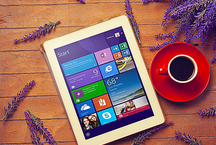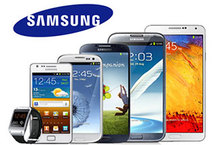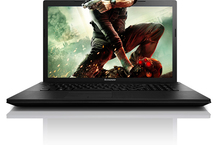
Photo: techspiel.com
This guide is a good help for choosing the best laptop, hybrid or Windows tablet, but you should start by mentioning such devices that were most popular in 2013.
No one will tell you that you made a mistake with the choice if this choice fell on the latest version of the Apple MacBook Air. Both 13- and 11-inch models received an updated Intel Core i5 processor and show brilliant results in battery life.
Something similar under Windows is an expensive 13-inch Samsung Ativ Book 9 Plus, which demonstrates image quality above HD. Laptop Lenovo IdeaPad Yoga 2 Pro has a similar high resolution, and, thanks to the ability to develop, easily turns into a tablet - and it costs less than $ 1000.
A very inexpensive option, quite suitable for surfing the Internet and chatting, is a 14-inch HP Chromebook 14 with the Google Chrome OS operating system.
Since 2012, the picture on the mobile device market has changed a lot. Windows 8 (updated to version 8.1) has become the default operating system, and its tiled interface means that the touchscreen has become the standard for almost any new laptop. In addition, after a protracted drought on the market for Windows tablets, the era of Win 8 spawned dozens of these devices, many of which are not some simple tablets, but ambitious hybrids with rolling, rotating, and even removable screens.
Many of the manuals, which explain how to choose the right computer, are replete with technical data. We will highlight the most important characteristics that need to be considered when buying a new laptop, and give as detailed as possible explanations for each of them. Let's start with the three fundamental rules laptop selection.
Three fundamental rules for choosing a laptop
1. A good laptop should not be much
If you remember, a few years ago the price of $ 1000 was considered normal for a budget laptop. Today, for this money, you can buy a premium-class device, and only Apple (although others are also trying) with their regular price hikes out of the general chorus.
Therefore, when they write to us, “I need a laptop to study, but I only have $ 1,500,” we usually advise to slow down and buy to start with some ordinary thin laptop for $ 700- $ 800.
And for the money it will not be a low-power plastic box. Intel Core i5 processors and touchscreens in elegant slim cases with a 128 GB SSD are what you can buy at this price. This is more than enough for most users, unless they are going to edit HD video or play the most advanced games.
In short, all these years, people have bought too many laptops. The short-lived era of $ 300 netbooks was thrown off the market in the opposite direction, but now everything has stabilized in the blessed middle. Touchscreens and hybrids slightly raised the average price, but still there are no problems for $ 999, or even cheaper, to grab a premium-class laptop or hybrid.
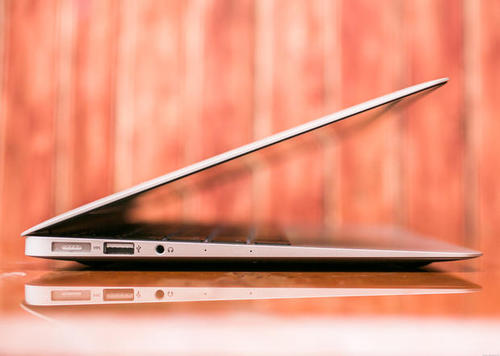
Photo: cnet1.cbsistatic.com
2. Think in terms of mobility
When people ask me what kind of laptop, I start by answering with a question: “How many days a week are you going to carry it with you?”.
The answer determines what the screen size will be, what the size and weight of the system as a whole depends on. For those who travel a lot, light 13-inch ultrabooks (like the MacBook Air) will do. An amazing breakthrough was made by ultraportable laptops with monitors at 11.6 inches, and with the most recent 11-inch hybrids and Windows tablets, the “screen” can be unplugged and taken with you, leaving the fixed keyboard at home or at work.
More average mid-sized laptops, such as 15-inch laptops, are likely to be in front of you now, and wearing them somewhere more than once a week is not very fun.
And finally, if you are convinced that you will never have to take this laptop with you, well, or very, very rarely, then a solid 17 or more inch desktop replacement will work for you. Keep in mind that most of these large laptops do not like to leave the vicinity of the outlet for a long time, and today, in the era of Windows 8, very few of them have a touchscreen.
3. Design is our everything
Following the results of testing and measuring the performance of hundreds of laptops, I dare say the following: inside they are all surprisingly similar. I will say even this: most laptops are assembled from the same set of processors, hard drives, memory, video cards - and all this painfully resembles consumer goods.
And here comes his majesty Design. Since most laptops of a certain class with similar components work roughly the same way, it is appearance that determines why some models are preferred by others.
Consider your laptop as an extension of your personality: you can carry it with you all day, or even around the world, you send letters from it, store personal photos and documents on it and use it to connect with other people on social networks.
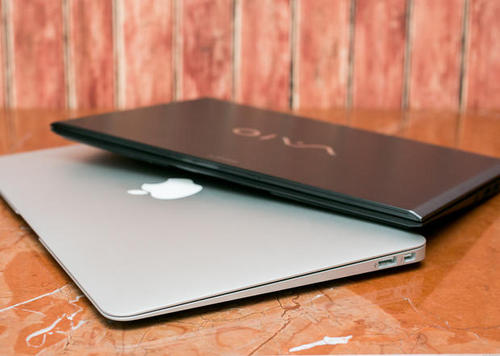
Photo: cnet3.cbsistatic.com
And like any personal accessory, such as glasses or an item of clothing, you must choose a laptop so that it fits your style, so that its design works for you and you feel comfortable, so that the keyboard and touchpad are comfortable.
Apple understood that perfectly. The MacBook stuffing is not much different from the stuffing of other laptops (the operating system is another matter), but their user interface is just fantastic, and the design has become the standard, this is how people imagine a “real” laptop.
Today's ultrabook enthusiasm confirms these words about the design, confirms them, and aggressive advertising with the Samsung Ativ 9 and Asus Transformer Book with impeccable appearance.
A laptop is a significant investment, the physical embodiment of which is likely to be with you every day. And if it comes to choosing between the design that you like and small technical differences, I would notice that almost all advanced laptops are powerful enough to perform everyday tasks - so choose a design.
Types of laptops
There are many options for separating laptops into categories. There are, for example, such: multimedia, gaming, thin and light, ultrabooks, ultra-thin and ultraportable. Term "Ultrabook" It occurs very often, but technically it is not a category at all, but simply the Intel trademark, which is awarded to laptops that fit the requirements of this corporation. Most of them resemble a 13-inch MacBook Air, but you can also find 14- and 15-inch ultrabooks. Sometimes systems that are also very thin, but not Intel’s parameters, are called “fake books” (fauxtrabooks) or simply ultrabook-like.
To understand all this zoo, we will take the screen size as the defining parameter - which is quite consistent with the above tips on choosing a laptop, based on how often you have to travel with it. This is the most common categorization of laptops, for example, on CNET.

Photo: cnet1.cbsistatic.com
Ultraportable (11-12 inches)
Ultra-portable systems with 11- and 12-inch screens returned to the market through the efforts of Sony and Apple, as well as with the emergence of hybrids of Lenovo, HP and other manufacturers. They usually run low-voltage Intel Atom processors or something from the AMD E line. The price of 11-inch tablets for Windows 8 starts at $ 499, and the additional keyboard will cost about $ 100.
13 inch laptops
This is the only screen size that deserves to be selected in a separate category. Such devices occupy their own ecological niche. 13-inches is the smallest laptop size that you can comfortably work with all day long, and at the same time it is the largest computer that you can easily carry around with you more than once or twice a week.Typical representatives are Apple MacBook Pro and Air, as well as Sony Vaio Pro 13.
As already mentioned, “ultrabook” is a trademark of Intel, which is often used to denote light 13-inch notebooks less than 18 mm in thickness and with an SSD-drive. Since almost all 13-inch laptops are ultrabook thick, the marketing term fades into the background and you can forget about the formalities. In other words, if the computer in all like an ultrabook, even if it is called that, you do not need to invent anything.
Some hybrids and transformers also fall into the category of "13 inches", although the 13-inch tablet looks a bit monstrous.
Midsize (14, 15 and 16 inches)
This category is formed by traditional 15-inch laptops, along with their 14-and 16-inch brothers. Although technically they are considered mobile devices, most of them lead a sedentary lifestyle or move along a home-work trajectory.
Most mid-size notebooks have dual or quad-core processors, usually Intel Core i, as well as 4 or 8 GB of memory and large hard drives of at least 320 GB. Add-ons like a separate GPU or Blu-ray-drive are rare, although they are available. Intel allows to call ultrabooks and some 14-inch and 15-inch laptops, if they have certain dimensions and satisfy a number of specific requirements. But it is rare.
Niche prices and opportunities mid-size - the widest, and the cheapest of them cost about $ 500, and the top bar is far beyond the $ 1000 mark. A typical configuration is from $ 800 to $ 1000.
Desktop computer substitutes (17 inches and more)
These massive laptops with screens from 17 inches literally take the place of a combination of the system unit, monitor and keyboard, but in case of emergency it is not a big deal to transfer them.
As a rule, the quad-core processor and the Nvidia or AMD graphics card work here. The image must be at least 1080 p, 1920 × 1080 so that there are no problems with Blu-ray and other high-quality graphic content.
Although the 17-inch variants are most typical for this category, there are quite a few 18-inch models, and these large desktop substitutes turn into real medical complexes for the home, for the family, where work, games, video and audio are all in one. Sometimes you can find specimens with detachable 18-20-inch screens that turn into giant tablets of dubious portability.
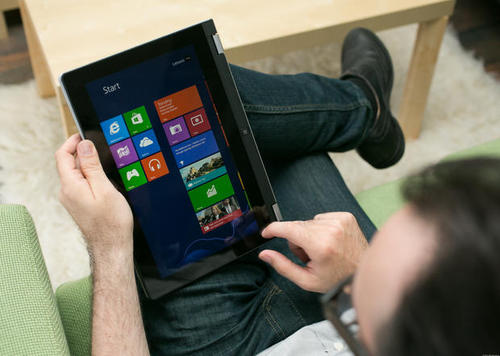
Photo: cnet4.cbsistatic.com
Hybrids, tablets and transformers
Most mobile computers with detachable, flipping, or folding screens have displays with a diagonal of 11.3 or 13.3 inches and behave almost the same as ordinary double-laptops of the corresponding category. Some, such as representatives of the Lenovo Yoga line, most of the time and look like regular laptops, others, such as Microsoft Surface Pro, spend their lives mostly in tablet mode.
Typical processors are Intel Atom and Core i5, which is why hybrids cost at least $ 499, and some go off scale for 1000. Today, quite a few hybrids can be considered mainstream solutions, mainly because Windows 8 has not yet grown to the status of a real tablet operating system. In addition, many detachable keyboards and touchpads of such systems are simply terrible. And yet, if you are looking for a smaller mobile device, we advise you to look not only at the traditional double-wing variants, but also not to miss the same size hybrids.
CPU / Processors
Whether you like it or not, some technical things will have to be given some attention. It will be about modern Intel and AMD processors and about where they live.
AMD
This company (it’s also the parent company of the graphics processor manufacturer, formerly known as ATI) recently released a new generation of accelerated processor devices.In AMD, they are not called CPUs (Central Processing Unit, CPU), but UPUs (accelerated processor units, Accelerated Processing Unit, APU) and mean by this the combination of CPUs and a separate graphics processor - but in one “bottle”.
The new AMD A4, A6, A8 and A10 chips have begun to populate Acer, HP and other manufacturers since this spring, but are also suitable options for budget and middle class computers. Please note that there are significantly fewer laptops with AMD processors than with Intel processors.
A complete list of AMD processors can be found on the website of this company.
Intel
If you choose a laptop, tablet, hybrid, or even a desktop, it is more likely that an Intel processor is inside it. The models of the last line have the same names as the representatives of the three previous generations, which leads to some confusion. However, the chips, which saw the light in June 2013, are known under the code name Haswell (the previous generation was Ivy Bridge).
These fourth-generation CPUs released in 2013 are easy to identify by the number four, with which part of their code designation begins. For example, the new Sony Vaio Pro 13 is equipped with an Intel Core i5-4200U 1.6 GHz processor. More technical details are set forth on the Intel site.
The difference in performance between the latest generation and the previous generation of processors is small. Haswell, however, can seriously save battery life, and the very first laptops we tested, equipped with these CPUs, wiped the nose of the 13-inch MacBook Air with its advertised 12 hours of battery life. So far, the search for a laptop with Haswell is a real quest, but it must be assumed that soon any model designed for mobile work will be equipped with them.
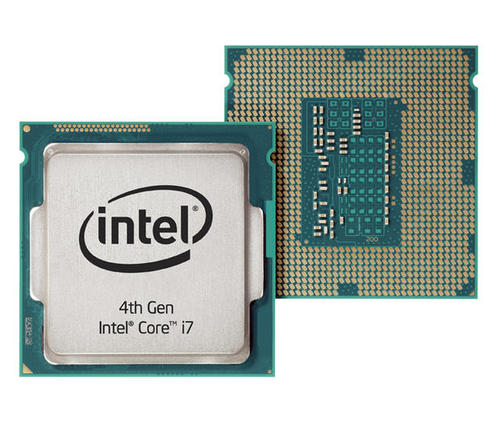
Photo: cnet4.cbsistatic.com
- Core i3 works in many budget and middle class laptops, two cores for everyday needs is enough.
- Core i5 represents the main direction of Intel's processor engineering and works in many 15- and some 17-inch laptops in the price range from $ 600 to $ 1000.
- Core i7 It is available in a quad-core version and can be found inside more expensive and productive machines that are needed only by gamers or those who work professionally with video.
- Pentium, Celeron and Atom are still being produced (yes-yes!) and live in an energy-efficient niche, and the authors of serious computer reviews recall them with a grimace of disgust. If possible, avoid laptops with Pentium and Celeron chips. The latest version of the Atom, formerly known as the Bay Trail, has decent performance and shows excellent power consumption in small tablets and hybrids.
- Xeon - processor for high-performance workstations. Most likely, you will never intersect with it unless you are interested in a new cylindrical Apple Mac Pro desktop or any other system not for normal use.
Hard drives and solid-state drives
Your new laptop will have either a “traditional” hard disk with rotating plates (HDD) or a solid state drive (SSD), i.e. None other than flash memory, similar to SD cards and what is installed in smartphones. There are also hybrid drives in which a small (20 or 32 GB) SSD works together with large HDD sizes. Theoretically, this allows the system to load faster and speeds up the work of applications, but, for example, music and video files are stored on the hard disk.
- HDD still remain the main drives in most laptops. Hard drives are spacious and inexpensive, but they are massive and warm, and they have many moving parts. You need to choose at least a 320-gigabyte hard drive, even for budget systems. Most discs rotate at a speed of 5400 revolutions per minute (in English denoted as RPM), but there are also faster - at 7200, which are useful for a significant amount of streaming data, video editing and games.
- SSD they work silently and barely heat up, but much more expensive and less capacious.The 11-inch Apple MacBook has a total of 64 GB SSD installed, and it costs such a pleasure $ 999. There is the possibility of upgrading to 128 and 256 GB, but it will cost a bit more. There is no doubt that SSD is the future, but at the moment their capacity is relatively small and they cannot be stored, for example, a large video collection.
Frequently asked Questions
What ports and extra features do I need?
A pair of USB ports at least. Most modern laptops have at least two USB 3.0 ports that are faster than USB 2.0, but only when USB 3.0-compatible devices are connected, such as hard drives. The need for an SD card slot is not even discussed. As well as the HDMI video output. Every laptop today has Wi-Fi compatible with almost all standards of this protocol and with any routers.
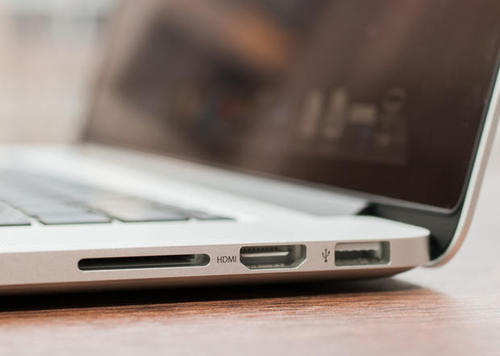
Photo: cnet4.cbsistatic.com
What ports and additional features can be waived?
Most laptops still have old-fashioned VGA video output, but if you don’t want to connect something like a CRT monitor, you don’t need it. DisplayPort for video or Thunderbolt (such high-speed interfaces) are needed only if you have compatible devices. The thinnest notebooks often lack the Ethernet connector, which is considered to be replaced by Wi-Fi. Not a fact at all, and let it be just in case. But if it's not there, it's not the end of the world. Bluetooth is good, but only if you intend to use a Bluetooth mouse, Bluetooth speakers, or Bluetooth headphones. Otherwise, it is useless, and if there is - it is useful to turn it off so as not to put the battery in vain.
Do I need a cd / dvd drive?
Rather no than yes, and in quite a few thin and light notebooks it cannot be in principle. But it is useful to leave it, because there are quite a few people who still have huge archives of films, music, games and other useful things on CD and DVD. Those. many are literally tied to optical discs - leave for them.
Do I need a video card?
Unless you are going to play very serious games (Skyrim, Metro: Last Light, etc.) on this laptop, you will have more than enough regular computer capabilities. The current versions of the integrated Intel GPU belong to the HD 5000 family. They will not pull serious (like those mentioned) games, but they will cope with normal or recently considered “serious” games. Yes, and with the new cope, if you reduce the image detail.
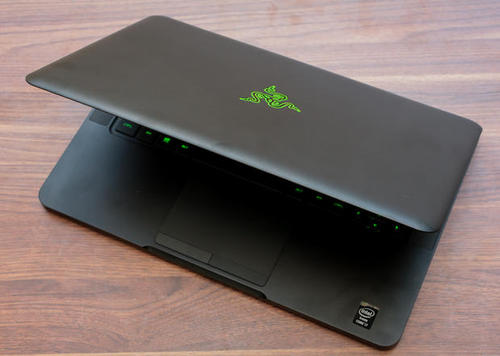
Photo: cnet1.cbsistatic.com
Which is better: a tablet on Windows or a laptop?
Windows tablets for a very long time did not cause anything but disappointment, and only with the advent of Windows 8 did some kind of animation come about. After all, Windows 8 can work with touchscreens as with relatives (though not always, as with the closest relatives), and most tablets and hybrids under this system can function in laptop mode or have the appropriate accessories. If you are typing a lot or are actively using the mouse or touchpad, it is better to choose a traditional laptop or a very laptop-like hybrid like Lenovo Yoga.
Which is better: Windows or Mac OS X?
This is one of the most provocative questions. Windows fans appreciate its flexibility, the ability to fine-tune and personalize the system. It runs on almost any hardware, and with the advent of the eight it became more friendly to touchscreens and tablets and got a dashing modern interface, which was a big breakthrough.
The Apple operating system only works on select desktops and laptops. At the same time, the presence of a common software and hardware platform allows creating much more stable and predictable programs, and the same impression remains with the user. And this is not to mention the fact that many prefer the user-friendly design and navigation and control elements of OS X. But under Windows there are incomparably more programs written, especially free ones; and, of course, games.
Do I need to buy right now, or is it better to wait for the next update / upgrade / OS / CPU, etc.?
This is a million dollar question and it concerns almost anything related to technology.Even the new device, while being brought to the house, is already a bit out of date and is becoming more and more antiquated every day, because the next new version is almost at hand. This must be realized, and when you understand this, it will become easier for you, you will be able to relax and buy something that will give you pleasure. There is nothing to dry on upgrades.
